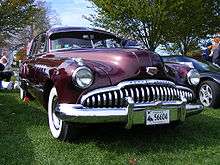Buick Motor Company
Buick originated as the Buick Auto-Vim and Power Company in 1899, an independent internal combustion engine and motor-car manufacturer, and was later incorporated as the Buick Motor Company on May 19, 1903, by Scottish born David Dunbar Buick in Detroit, Michigan. Later that year, the company was taken over by James H. Whiting (1842–1919), who moved it to his hometown of Flint, Michigan, and brought in William C. Durant in 1904 to manage his new acquisition. Buick sold his stock for a small sum upon departure, and died in modest circumstances 25 years later.
Between 1899 and 1902, two prototype vehicles were built in Detroit, Michigan by Walter Lorenzo Marr. Some documentation exists of the 1901 or 1902 prototype with tiller steering similar to the Oldsmobile Curved Dash. In mid-1904, another prototype was constructed for an endurance run, which convinced James H. Whiting to authorize production of the first models offered to the public. The architecture of this prototype was the basis for the Model B.
The first Buick made for sale, the 1904 Model B, was built in Flint, Michigan. There were 37 Buicks made that year, none of which survived. There are, however, two replicas in existence: the 1904 endurance car, at the Buick Gallery & Research Center in Flint, and a Model B assembled by an enthusiast in California for the division's 100th anniversary. Both of these vehicles use various parts from Buicks of that early era, as well as fabricated parts. These vehicles were each constructed with the two known surviving 1904 engines. Buicks were first built to replicate the living room in a moving automobile, and were nicknamed the "moving couch of America".
The power train and chassis architecture introduced on the Model B was continued through the 1909 Model F. The early success of Buick is attributed in part to the valve-in-head, or overhead valve (OHV), engine patented by Eugene Richard and developed by David Dunbar Buick. The Model F had a two-cylinder engine, an 87 inch wheelbase and weighed 1,800 lbs. The creation of General Motors is attributed in part to the success of Buick, so it can be said Marr and Richard's designs directly led to GM.
The basic design of the 1904 Buick was optimally engineered even by today's standards. The flat-twin engine is inherently balanced, with torque presented to the chassis in a longitudinal manner, actually cancelling front end lift, rather than producing undesirable lateral motion. The engine was mounted amidships, now considered the optimal location.
Durant was a natural promoter, and Buick soon became the largest car maker in America. Using the profits from this, Durant embarked on a series of corporate acquisitions, calling the new megacorporation General Motors. At first, the manufacturers comprising General Motors competed against each other, but Durant ended that. He wanted each General Motors division to target one class of buyer, and in his new scheme, Buick was near the top — only the Cadillac brand had more prestige. Buick occupies this position to this day in the General Motors lineup. The ideal Buick customer is comfortably well off, possibly not quite rich enough to afford a Cadillac, nor desiring the ostentation of one, but definitely in the market for a car above the norm.
In 1911, Buick introduced its first closed-body car, four years ahead of Ford. In 1929, as part of General Motors' companion make program, Buick Motor Division launched the Marquette sister brand, designed to bridge the price gap between Buick and Oldsmobile; however, Marquette was discontinued in 1930. Buick debuted two major achievements for the 1931 model year, the OHV Buick Straight-8 engine and a synchromesh transmission in all models but the Series 50. The Eight was offered in three displacements, the 220 cubic inch (bore 2 7/8 in. stroke 4.25 in.), was available in the Series 50 with 77 brake HP. The Series 60 engine was a 272 cu. in. unit (bore 3 1/16 in., stroke 5 in.) giving 90 brake HP. The Series 80 and Series 90 used a 344 cu. in. version (bore 3 5/16 in., stroke 5 in.) for 104 brake HP. Automatic vacuum-operated spark advance was another new feature replacing the steering column mounted spark lever although an emergency lever was now dash mounted. Buick scored another first in 1939, when it became the first company to introduce turn signals. All 1939 models also had a steering column mounted shift lever.
In the 1930s Buicks were popular with the British royal family, particularly Edward VIII. He imported and used a Canadian built McLaughlin-Buick that were GMs top brand in Canada, Cadillac not having caught on there.
Buick Special (1936-1949)
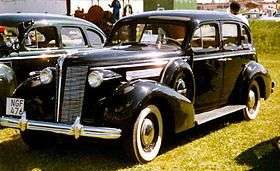
1937 Buick Special

1948 Buick Special
From 1936 to 1958, Buick's Special model range represented the marque's entry level full-size automobile. The '36 was a very successful year for Buick and also marked the first time of using names rather than the simple serial numbers which had been in use before. The Special continued to also be known as the 40-series, however. The first Specials rode on a 118 in (3.0 m) wheelbase, but for the next model year this was increased to 122 in (3.10 m) as all Buicks grew for that year. The engine was also new, and was now of 248 cu in (4.1 L) rather than 233 cu in (3.8 L). The Special (and all other Buicks as well) underwent a full restyling for 1939, with a more enclosed nose and a wider grille. The wheelbase was also two inches shorter. For 1940, there was the usual restyle and the wheelbase increased by an inch. This was also the only model year that a four-door convertible Special ("Sport Phaeton") was offered, although only 552 were built.
For 1941 the bodywork was again all new, with the front fenders now very closely integrated into the cars overall design. The Estate Wagon migrated from being a Super into the Special lineup. Also new was the 40-A series (the regular Special now being the 40-B), a version on a three inches shorter wheelbase which shared its body with the 1941 Chevrolet.
These two series, with a restyle reminiscent of the 1939 Y-Job, continued into the 1942 model year. By 1944 only the larger Special range remained available, still using the B-body. The '46 Special is rare, representing less than 2% of Buick's production that year. The Special continued with minor changes until the B-body was finally replaced halfway through the 1949 model year.
Buick Special 1949-1958
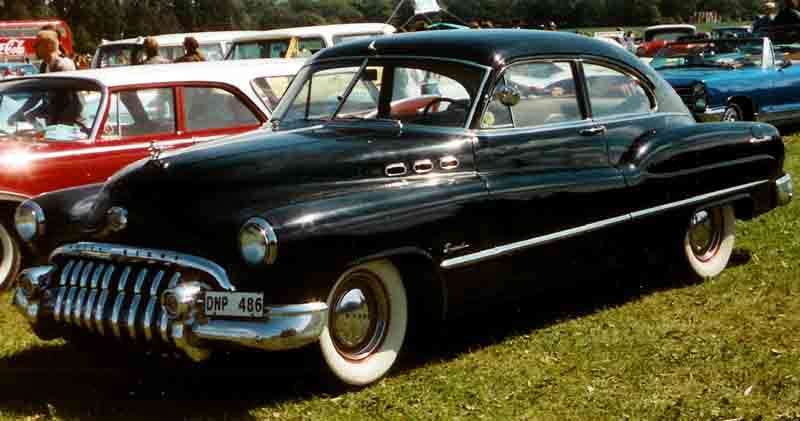
1950 Buick Special DeLuxe

1957 Buick Special
Halfway into the 1949 model year, the Specials received all-new bodywork. New was the 40D-series, a better equipped version called the Special DeLuxe. The engine remained the 248 cu in (4.1 L) which had been used since 1937, but for 1951 this was replaced by the larger "Fireball" straight-eight. A two-door hardtop coupe was also new for 1951. The 1954 Specials had an all-new body and chassis, much wider and lower, and were now equipped with the all-new, more powerful "Nailhead" V8 engines.
Introduced in the middle of the 1955 model year the four-door Buick Special Riviera (along with the Century Riviera, the Oldsmobile 98 Holiday, and the 88 Holiday) were the first four-door pillarless hardtops ever produced. By then, the Buick Special was one of America's best selling automotive series. For 1956 the larger 322 cu in (5.3 L) V8 engine was shared with the rest of the range, although it was replaced by the bigger, 250 hp (186 kW) 364 V8 for 1957. This year also brought all-new bodywork, as well as a four-door hardtop station wagon called the Buick Caballero. The 1957 wheelbase remained 122 inches. In the June, 1957 issue of Popular Mechanics, the Special was rated with a 0-60 mph time of 11.6 seconds, fuel economy of 17.4 mpg-US (13.5 L/100 km; 20.9 mpg-imp) at 50 mph (80 km/h), and ground clearance of 6.9 in (175 mm). 1958 brought the most chrome yet and twin headlights, as the car grew longer and wider, albeit on an unchanged chassis.
1949-1957 Buick Specials had three VentiPorts while more senior Buicks, with the exception of the Buick Super (which switched from three to four in 1955), had four. GM renamed the Buick Special the LeSabre for the 1959 model year, taking the name from the 1951 Le Sabre concept car.
Buick Super (1940-48 )
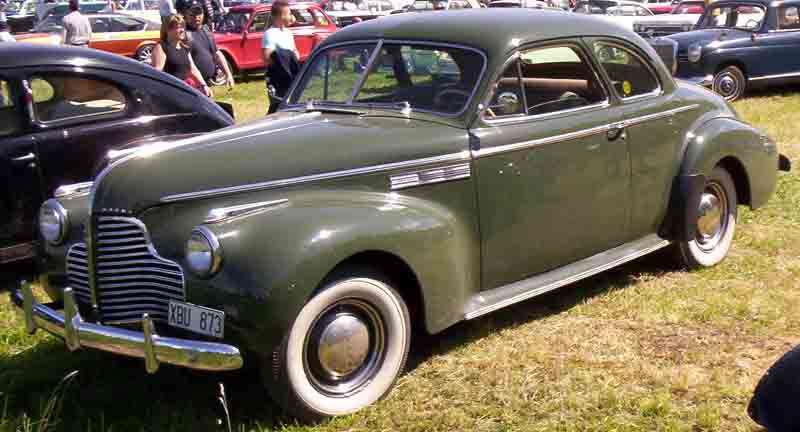
1940 Buick Super
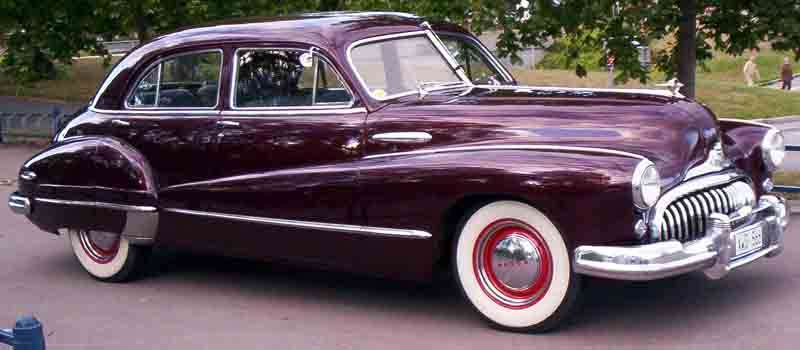
1947 Buick Super
When introduced in 1940 the new Series 50 Super featured the cutting-edge "torpedo" C-body. The new C-body that the 1940 Buick Super shared with the Series 70 Roadmaster, the Cadillac Series 62, the Oldsmobile Series 90, and the Pontiac Torpedo featured shoulder and hip room that was over 5" wider, the elimination of running boards and exterior styling that was streamlined and 2-3" lower. When combined with a column mounted shift lever the cars offered true six passenger comfort. These changes had clearly been influenced by the Cadillac Sixty Special.
The basic formula for the 1940 to 1952 Super was established by mating the Roadmaster's longer behind the engine cowl body to the Series 40 Special's smaller straight-eight engine (and consequently shorter engine compartment). This led to an economical combination of voluminous passenger room and relatively good fuel economy. (In contrast the Series 60 Century combined the smaller Special body with the larger Roadmaster engine.)
The new Super temporarily shared its 121.0 in (3,073 mm) wheelbase dimension with the 40 Special. Initially four body styles were offered: a 2-door coupe, a 2-door convertible, a 4-door sedan and a 4-door convertible. In the middle of the model year a 4-door Estate wagon was added which was exclusive to the Super. Interiors of Bedford cloth (either tan or gray) were offered. The engine was the same 248 cu in (4.1 L) 107 hp Fireball I8 as used on the Special which was equipped with an oil filter. The Super was equipped with sealed beam headlights and with Fore-N-Aft Flash-Way directionals. 1940 was the only year the Super could be equipped with sidemounts. A total of 128,736 units were sold in its first year.
The styling changes for 1941 were modest, but the changes under the hood were major. The compression ratio was raised from 6.15:1 to 7.0:1, the "turbulator" pistons were redesigned, smaller spark plugs were substituted for the previous type and “Compound Carburetion” was introduced, as it was on all Buicks except for the Special. Compound Carburetion was the forerunner of the modern four-barrel carburetor, and consisted of twin two-barrel carburetors. One unit operated all of the time, while the other operated only under hard acceleration. The new engine delivered 125 horsepower. All cars available with a choice of axle ratios and with two-tone color combinations with 19 selections at no extra charge. A new feature was a two-way hood that could be opened from either side. The 4-door convertible and the Estate wagon were gone but a new one year only body style was a 3-passenger 2-door Business Coupe which sold 2449 units. Overall sales fell to 92,067.
The 1942 Super coupes adopted the appealing Sedanet fastback style that had been the sensation of 1941 on Century and Special. New wider and lower bodies were offered and "Airfoil" front fenders that flowed into the lines of the rear fenders were introduced on convertibles and sedanet models. The Super had new front fender trim featuring parallel chrome strips. Also featured for 1942 was a handsome new grille with a lower outline and thin vertical strips. A feature shared with other Buicks was a new interior air intake positioned near the front center grille that eliminated the old cowl-level ventilator. The number of body styles was reduced to three with the elimination of the one year only Business coupe.
In 1946 Buick once again combined the large Series 70 Roadmaster body with the economical Series 40 Special powerplant to create the Series 50 Super line. Basic styling was continued from 1942 now sedans had the front fender sweep across the doors to the rear fenders as did the Sedanet and convertible styles. A stamped grille with vertical bars dominated the frontal ensemble. Single stainless body trim lines began on the front fenders and ended at the rear edge of the standard rear wheelhouse shields. Standard equipment included an automatic choke, clock, ash receiver, turn signals and woodgrained instrument panels. Exterior series identification was found on the crossbar between the bumper guards front and rear. Cloisonne emblems carried the Super emblem. Compound Carburetion was eliminated and the compression ratio was reduced to 6.30:1. As a consequence the 1946 Super's horsepower fell from 125 to 110. Torque on the other hand was hardly affected. The number of body styles increased to four with the return of the Estate wagon after a six year absence. A total of 119,334 units were sold. The front suspension was independent with coil springs. 76.98% of Buick sales this year were Supers.
Combining big Roadmaster room with an economical Special engine continued to make the Super an American favorite in 1947. The Super was little changed from its 1946 counterpart, except for new stamped grille that had separate upper bar and new emblem. Stainless lower body moldings made a single line along the body and continued onto the standard wheelhouse shields. A white Tenite steering wheel was standard while the instruments were round and set into a two-toned dash panel. Exterior series identification was found on the crossbars between the standard bumper guards. A chrome emblem was used with the series script embossed and filled with red. Sales reached a record 159,588. The height was 64.9 inches. Brakes were 12 inch drums.
The main external change to the 1948 Super from its 1947 counterpart was the Super script on each front fender. Other series identification continued to be earned on the bumper guard crossbar. The car was a bit lower than in 1947 rolling on new 7.60 x 15 tires mounted on wheels with trim rings and small hubcaps. Super script was also found on the center crest of a new black Tenite steering wheel. New cloth interiors featured leatherette scuff pads and trim risers. The instrument panel was redone, using silver-tone instruments on a two-tone gray panel. The sedan was carpeted in the rear with a carpet insert also found in the front rubber mat. The convertible also featured cloth and leather interior trim with power top, seat and windows standard. Total sales were 108,521.
Buick Super 1949-1953
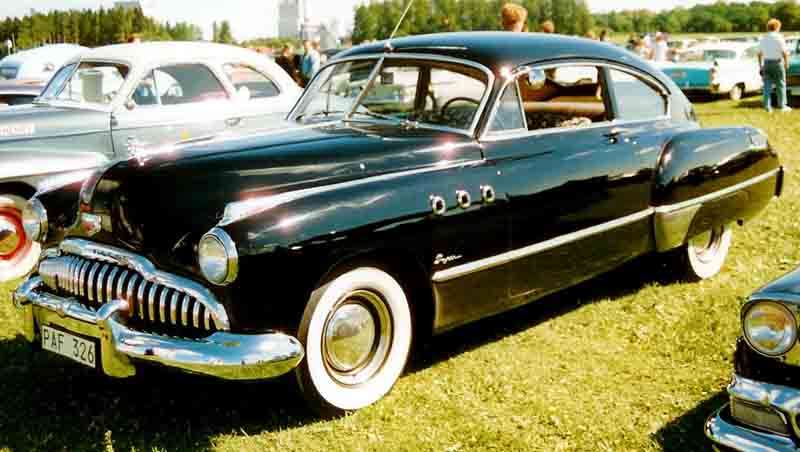
1949 Buick Super

1954 Buick Super Riveria
The Super shared a new General Motors C-body with the Roadmaster but on a shorter wheelbase. It featured three chrome VentiPorts on each front fender to denote its smaller straight-eight engine and shorter engine compartment when compared with the Roadmaster. The sales brochure noted that VentiPorts helped ventilate the engine compartment, and possibly that was true in early 1949, but sometime during the model year they became plugged. The idea for VentiPorts grew out of a modification Buick styling chief Ned Nickles had added to his own 1948 Roadmaster. He had installed four amber lights on each side of his car’s hood wired to the distributor so as to flash on and off as each piston fired simulating the flames from the exhaust stack of a fighter airplane. Combined with the bombsight mascot, VentiPorts put the driver at the controls of an imaginary fighter airplane. Upon seeing this, Buick chief Harlow Curtice was so delighted that he ordered that (non-lighting) VentiPorts be installed on all 1949 Buicks.
Super script was found just above the full length body fender molding on the front fenders. New fender edge taillamps were featured while rear fender skins remained a Buick standard. New fender top parking lamps, harkening back to 1941 styling appeared. Full wheel trim discs were standard along with such features as a cigar lighter, ashtray, and automatic choke. Cloth interiors were standard, except on the convertible which was trimmed in leather and leatherette and had a power top, seat and windows as standard equipment.
Dynaflow automatic transmission was now optional equipment on Supers in 1949. Cars so equipped had 6.9:1 compression ratio and 120 horsepower. Total sales set a record at 190,514 for the first time since the Super's introductory year. The instrument panel was new.
The 1950 Supers shared with all the other series totally new all bumper guard grille and more rounded styling. Super script appeared on front fenders just above the full length lower bodyside moldings. A new body style was a 2-door Riviera hardtop. Another new bodystyle was a long wheelbase sedan which was stretched an extra four inches (102 mm) and featured plusher interior than most Supers, which normally had cloth interiors of finer material than the Special. Supers had three VentiPorts on each hoodside. The convertible had leather power seats plus power windows and top.
The 1950 Super came with a single two-barrel carburetor on a new higher displacement 263 cu in (4.3 L) Fireball I8 which produced 112 hp (84 kW). It was able to achieve speeds over 90 miles per hour (140 km/h) with an optional Dynaflow automatic transmission which, rather than changing through gears, used the torque converter to couple the motor to a single gear ratio. The car had 2 splits in the back glass although the windshield was now curved one-piece glass. Models also could be equipped with an AM radio and an antenna that could be adjusted via a knob in the front center above the windshield. In the June 1953 Popular Mechanics, acceleration was rated at 0-60 mph in 14.5 seconds. The Super set an all time record of 251,883 sold.
In 1951 Supers had larger bodies than Specials but looked similar with three rounded VentiPorts per fender, broad bright fender shields and a full length "Sweepspear" chrome body side molding. This chrome-plated strip started above the front wheel, after which it gently curved down nearly to the rocker panel just before the rear wheel, and then curved around the rear wheel in a quarter of a circle to go straight back to the taillight. Series script was found on the deck lid and within the steering wheel center. The long wheelbase sedan was named the Riviera sedan although it was not a hardtop. Supers were trimmed with materials similar to Special Deluxes except for in the plush Super Riviera sedan. Front turn signals were within the bumper guard "bombs," while rear signals shared the stop lamps' housing on the rear fender edges. The convertibles and Estate wagon were trimmed in leather. 169,226 Supers were sold.
In 1952 Buick's mid-priced line resembled the Series 40 with three VentiPorts per fender and Sweepspear rocker panel trim. Super script appeared on the rear fenders aided identification. The Super was built with the larger C-body, however. The full flowing fenderline dipped deeper on this body and rear fenders had a rear crest line absent on the B-body Specials. A new deck lid gave a more squared off appearance. Like other Buick series it was a near copy year for 1952. Chromed rear fender fins gave distinction to 1952 Supers. Interiors were cloth except on convertibles and Estate wagons which were trimmed with leather. The Super used a different instrument panel than the Special. It was distinguished by a large center speedometer housing flanked by smaller gauge housings. Series identification was found within the steering wheel center. The Sedanet and the regular wheelbase sedan were cancelled. Sales fell to 135,332.
In 1953 Buick's middle priced line shared the Roadmaster's new V8 and, for this year the Roadmaster shared the Super and Special's 121.5 in (3,086 mm) wheelbase. The Super earned a horizontal trim bar on its rear fenders which distinguished it from the Series 70 Roadmasters. Otherwise its side trim bar on its rear fenders was identical although the Super was had only three VentiPorts on each front fender. Series identification was found on the deck emblem. Full wheelcovers were now standard. The vee in the bombsight ornament signified the V8 power under the hood. Interiors in most models were nylon and silky broadcloth. The convertible had power windows, seat and top as standard equipment. Dynaflow was now standard equipment. Air conditioning was a new option. A total of 190,514 Supers were sold.
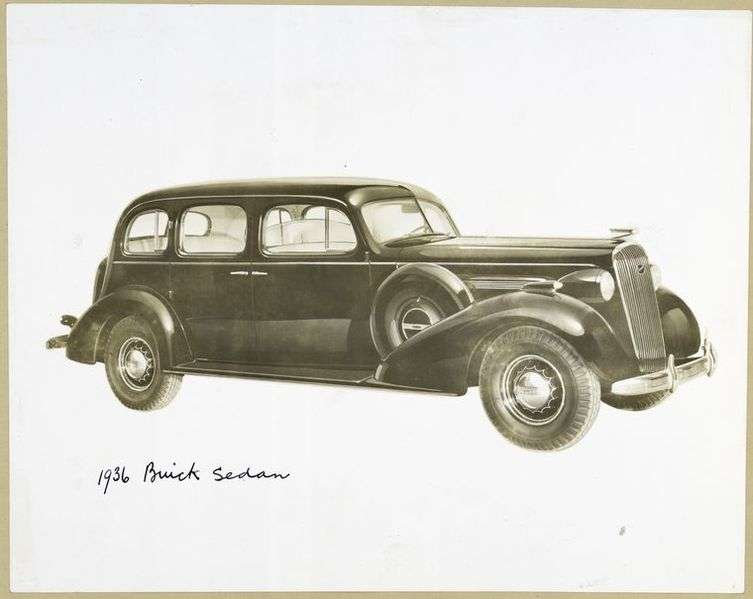
1936 Buick Roadmaster
1936-37 Buick Roadmaster
The origins of the Roadmaster name date to 1936 when Buick added names to its entire model lineup to celebrate the engineering improvements and design advancements over their 1935 models. Buick's Series 40 was named the Special, the Series 60 was named the Century and the Series 90 — Buick's largest and most luxurious vehicle — was named the Limited. The Series 50 was retired, but new for the model year was the Series 80 Roadmaster. The implications of the name were clear, for as the 1936 Buick sales catalogue said, "It literally named itself the first time a test model leveled out on the open highway."
The Roadmaster was introduced in a year when Buick's valve-in-head straight-eight engines were heavily revised. Buick reduced the number of engines from four sizes to two: a 233-cubic-inch, 93-horsepower job for the Special, and a big, 320.2-cubic inch, 120-horsepower engine for the other series. (To put the size and power of Buick’s larger straight-eight engine in context, compare it to the new 322-cubic-inch mono-block 120 horsepower V-8 that Cadillac introduced that year.) In addition to this major engineering change 1936 was also the year Buick adopted an all steel turret top and hydraulic brakes. Coil springs were in the front.
The Roadmaster was a big car, in sedan form tipping the scales at 4,098 pounds, some 88 pounds heavier than Cadillac's new Series 60. But pricewise, the Roadmaster was a tremendous bargain. The sedan sold for $1,255, $440 less than the least expensive Cadillac. The only other body style available was a four-door convertible phaeton, priced at $1,565 (of which only 1064 were produced), at a time when a Cadillac in the same body style sold at prices ranging from $2,745 to $7,850. Buick’s new engineering and styling was a big hit, with model year sales more than tripling from just over 48,000 to nearly 158,000, and with the all new Series 80 Roadmaster contributing a total of 16,049 units to that number.
With Roadmaster being a completely new model, and with Buick having totally restyled its entire line the previous year, one might have expected only modest changes for 1937. But that was not the case. The Roadmaster gained a divided grille with horizontal bars. The center section of the grille was painted to match the body of the car. Fenders became squared off and the headlight shells were gracefully streamlined. Overall height fell by 1.5 inches (38 mm) without sacrificing interior room. A new carburetor and revised camshaft raised engine horsepower to 130. The engine also received a new intake manifold, oil pump, cooling system and a quieter overhead valve mechanism. A formal sedan, featuring a roll-down glass partition between the front and rear compartments, was added to the Roadmaster line for $1,641, of which 452 were sold. The price of the sedan was raised to $1,518, and that of the phaeton to $1,856, or by 21 percent and 19 percent respectively. Nevertheless, overall Roadmaster sales increased to 16,129.
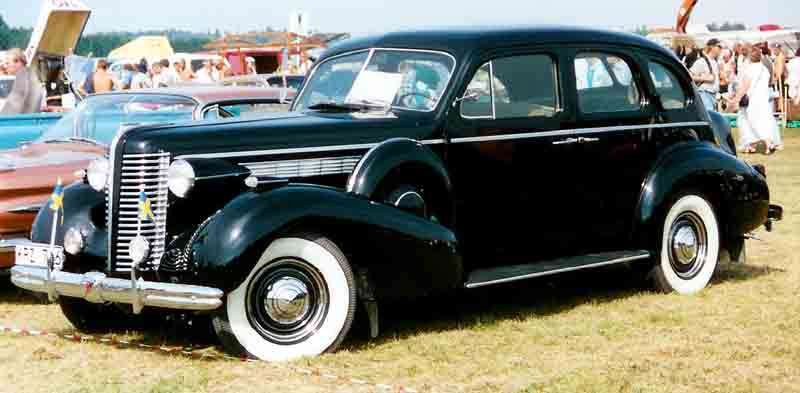
1938 Buick Roadmaster
1938-39 Buick Roadmaster
Styling changes for 1938 were modest, with a longer hood extending to a now nearly vertical grill, taller bumper guards and redesigned hubcaps, but the effect was striking. Important changes were made to both engine and chassis. The ride was improved by replacing the rear leaf springs with coil springs, supported by double-acting shock absorbers that were some four times the size of any others on the market. The frame X-member was changed from I-beam to channel construction and all wood structural elements were replaced with steel. The engine combustion chambers were redesigned and new "turbulator" pistons raised the compression ratio from 5.9 to 6.5:1, resulting in an increase in horsepower to 141.
The 4-door convertible phaeton traded its built-in trunk look for a fastback appearance, and a new fastback sedan was added to the line with 466 being sold. The Roadmaster's price was increased, but not as swiftly as the previous year, going to $1,645 for the sedan. Although Buick’s overall market share increased in an off year, Roadmaster sales plummeted to 5568, falling from 7.3 percent to 3.3 percent of Buick's total output.
Styling for 1939 featured a new two-piece “waterfall” grille with thin vertical bars. The hood was narrower, front door pillars were narrower and hubcaps were larger. Window area increased substantially with the rear window changing to a one-piece design. On the interior all major gauges were moved to in front of the driver and the gear shift was moved to a column mount. The 4-door phaeton could now be ordered with the built-in trunk appearance or as a fastback, but only three of the later were actually sold. Although prices were reduced (the price of the sedan fell to $1545) sales only rose to 6097, with Roadmaster’s share of Buick’s total sales falling to 2.9 percent.
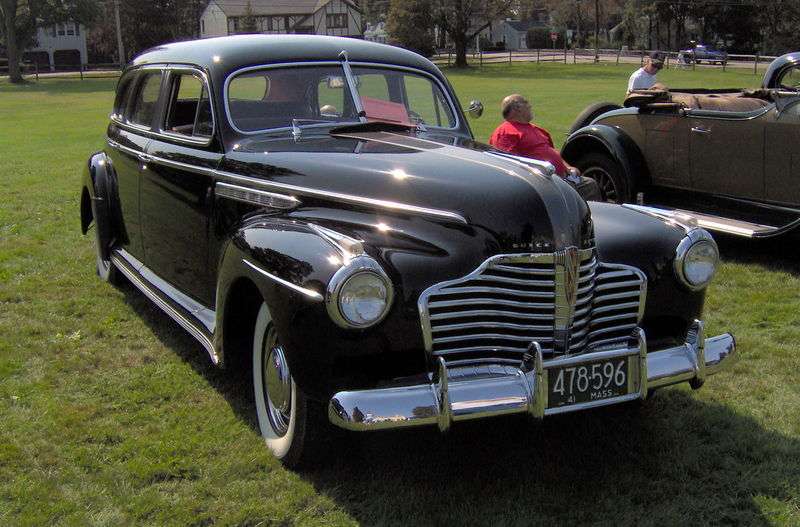
1941 Buick Roadmaster
1940-1941 Buick Roadmaster
In 1940 the Series 80 was renamed Limited. The Roadmaster name was transferred to the new Series 70, which was introduced at the same time as a brand new Series 50 Super. The Roadmaster featured a cutting-edge "torpedo" C-body. The new C-body that the 1940 Buick Roadmaster shared with the Super, the Cadillac Series 62, the Oldsmobile Series 90, and the Pontiac Torpedo featured shoulder and hip room that was over 5" wider, the elimination of running boards and exterior styling that was streamlined and 2-3" lower. When combined with a column mounted shift lever the cars offered true six passenger comfort. These changes had clearly been influenced by the Cadillac Sixty Special.
The 1940 Roadmaster had a shorter wheelbase, was lighter, and was less expensive than the previous year’s model. The formal and fastback sedans were gone, but for the first time a 2-door coupe was available, which sold a respectable 3,991 units. Also new for this year, the coach-building firm of Brunn was asked to design several custom-bodied Buicks for the Series 70, 80 and 90. Only one Roadmaster example is known to have actually been produced in 1940, an open-front town car not surprisingly called the Townmaster. Overall sales more than tripled to 18,345.
The styling changes for 1941 were modest, but the changes under the hood were major. The compression ratio was raised from 6.6:1 to 7.0:1, the "turbulator" pistons were redesigned, smaller spark plugs were substituted for the previous type and “Compound Carburetion” was introduced. Compound Carburetion was the forerunner of the modern four-barrel carburetor, and consisted of twin two-barrel carburetors. One unit operated all of the time, while the other operated only under hard acceleration. The new engine delivered 165 horsepower. With five more horsepower than a senior Packard, 15 more than any Cadillac, and 25 more than the largest Chryslers, it was the most powerful engine available that year on an American car.
A new bodystyle for this year was a 2-door convertible, which sold 1,845 units. There was also one Brunn designed convertible produced, but priced at $3,500 actual orders for the vehicle failed to appear. Overall sales remained respectable at 15,372.
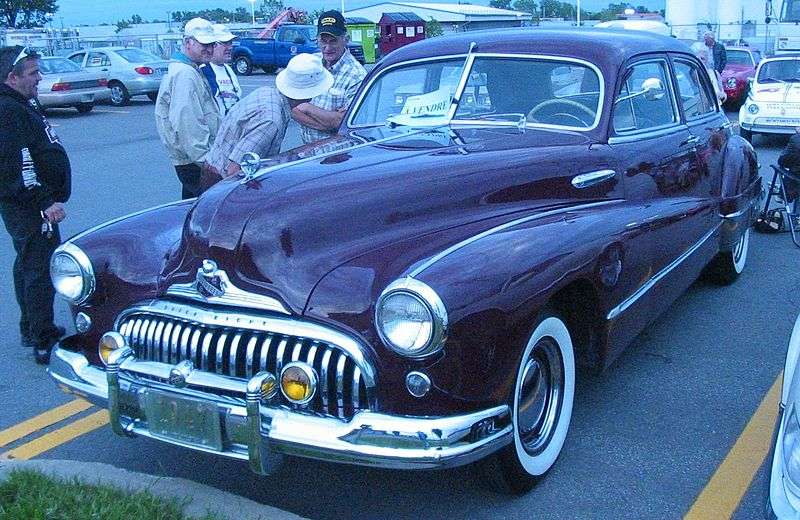
1947 Buick Roadmaster
1942-48 Buick Roadmaster
The 1942 Roadmaster was longer, lower, wider, and roomier than before (a Harley Earl trademark), thanks in part to a longer wheelbase. There was also a new vertical-bar grille and "Airfoil" fenders that swept back all the way to the rear fenders. Both features would become a Buick icon and would be exhibited in one way or another for years to come. The 4-door phaeton was dropped and would never return. Coupes adopted the appealing Sedanet fastback style that had been the sensation of 1941 on the Century and Special.
In the 1946 model year, chrome was more sparingly applied, swept-back fenders were fitted to sedans as well as coupes, and a air-forc-inspired "bombsight" hood ornament was adopted. The instrument panel was two-toned with woodgrains except on convertibles which used body colored panels. Series identification was found on cloisonne emblems centered in the bumper guard front and rear. Compound Carburetion was eliminated and the compression ratio was reduced to 6.60:1. As a consequence the 1946 Roadmaster's horsepower fell from 165 to 144. Torque on the other hand was hardly affected. Nevertheless, Roadmaster’s I-8 still produced more horsepower than a top of the line Chrysler's. But the biggest change was in sales proportions. Roadmaster increased its share of Buick sales from four percent in 1941 to 20 percent in 1946, with a total of about 31,400 sold.
In 1947 a new stamped grille with a separate upper bar was used. The Roadmaster name appeared in red-filled script on chrome button within the bumper guard crossbars, front and rear. All new was an Estate wagon body style. It sold 300 units and instantly became the top of the line in the station wagon market.
In 1948 a series script appeared on the front fenders and the white Tenelite steering wheel that had been used previously was traded in for a black one, in order match the change from a two-tone woodgrain instrument panel to a two-tone gray instrument panel, with silver tone instruments. A new optional Custom Trim option was offered, consisting of cloth upholstery with leather bolsters with the robe cord cover and lower door panels done in leatherette. Convertibles acquired power windows, seat and top as standard equipment. But the biggest advancement was the introduction of Dynaflow, the first passenger car torque converter transmission. Optional on Roadmaster in its first year, it was so popular that by the following it was standard equipment. Overall sales were just under 80,000 in both 1947 and 1948.












